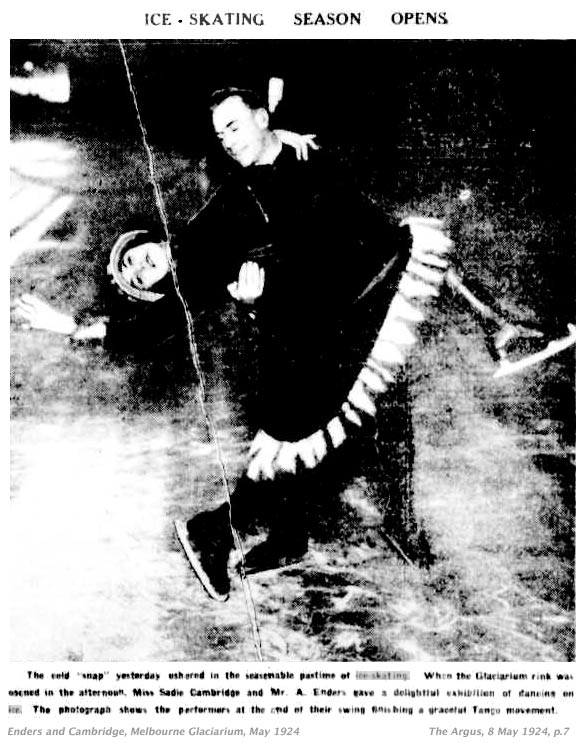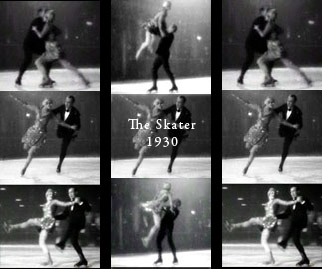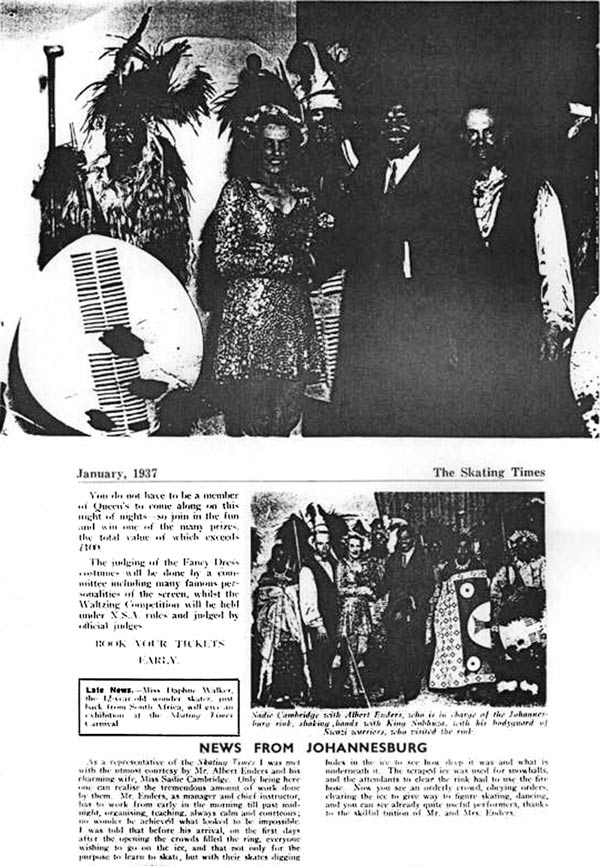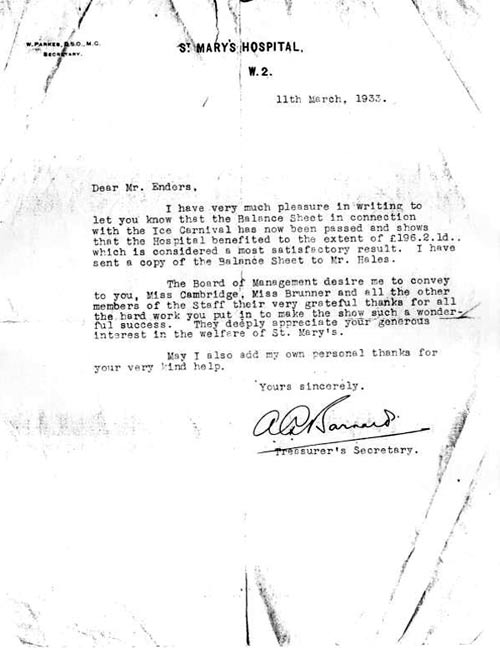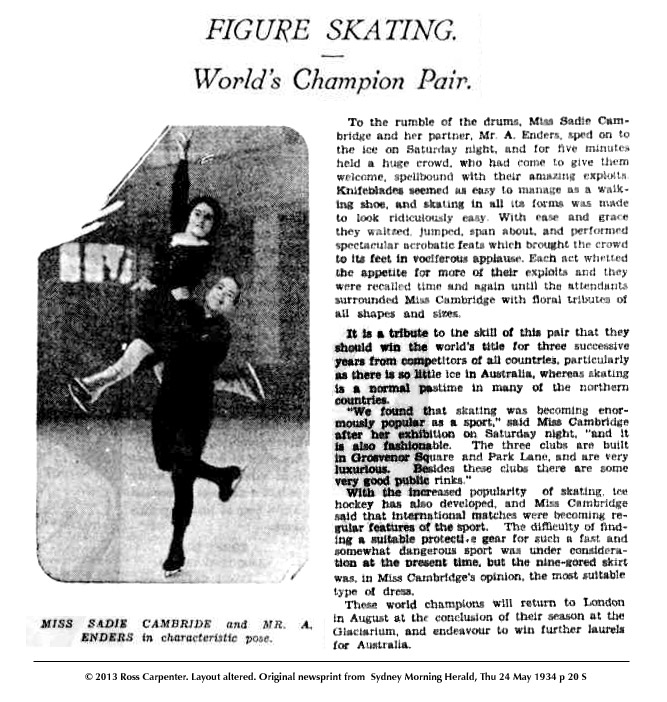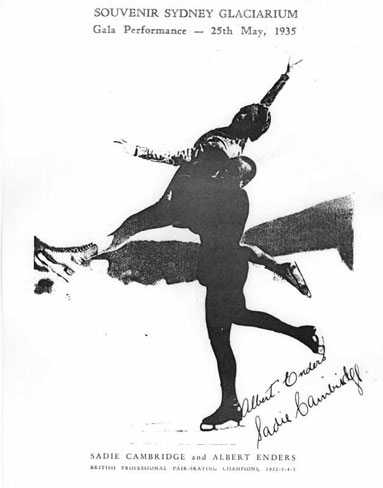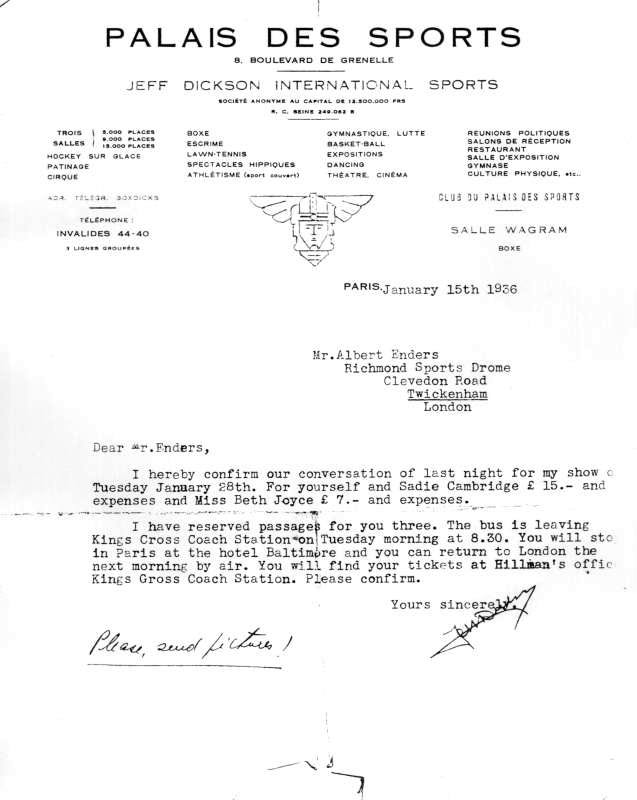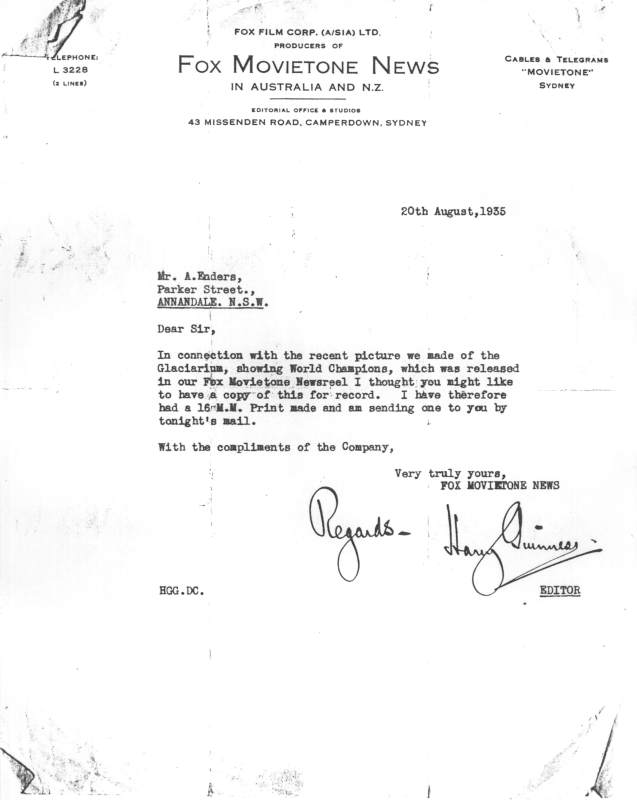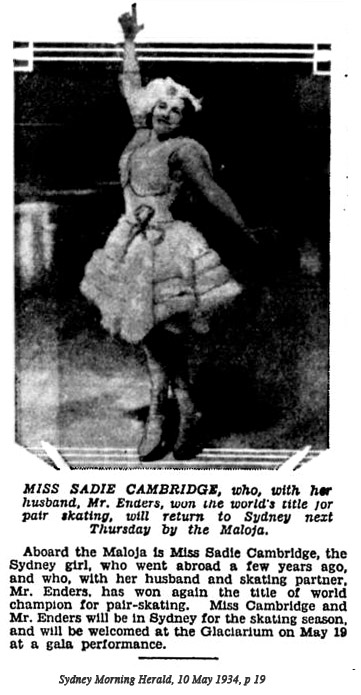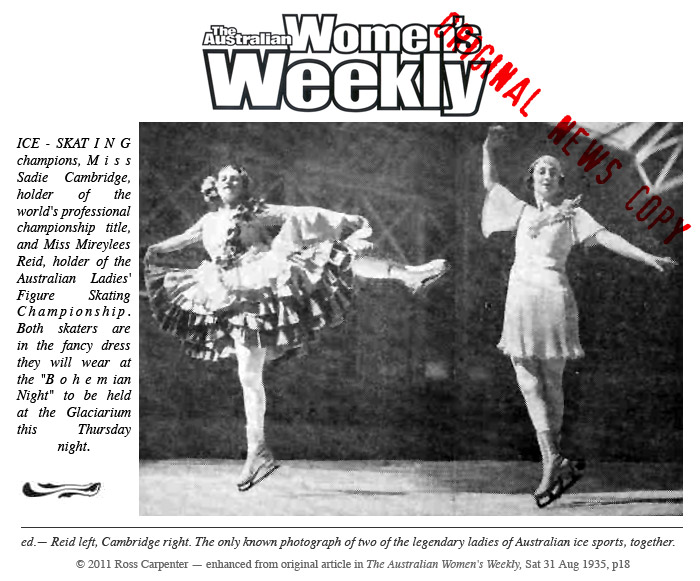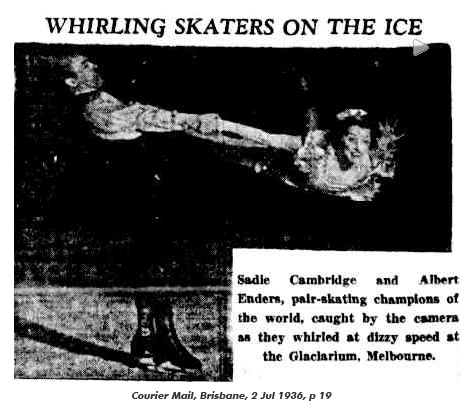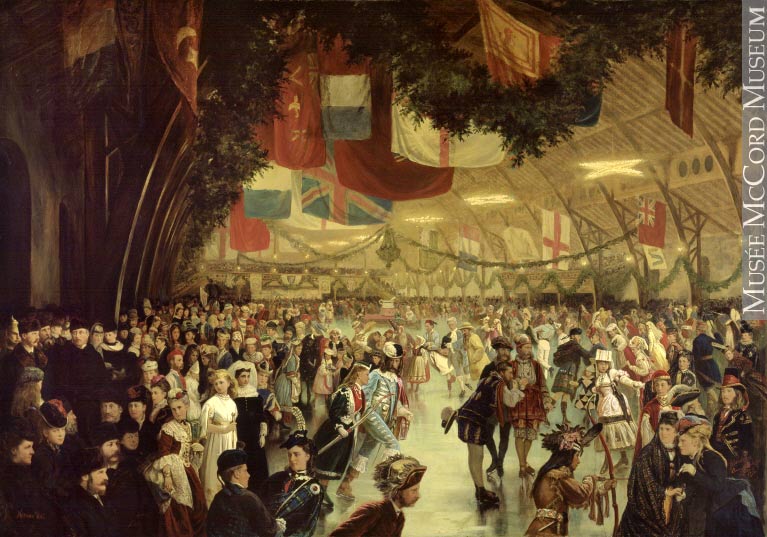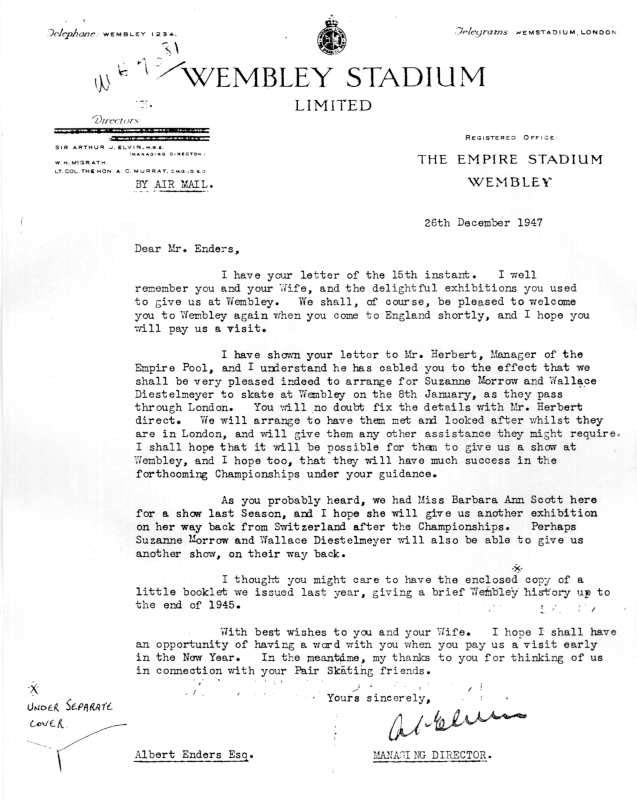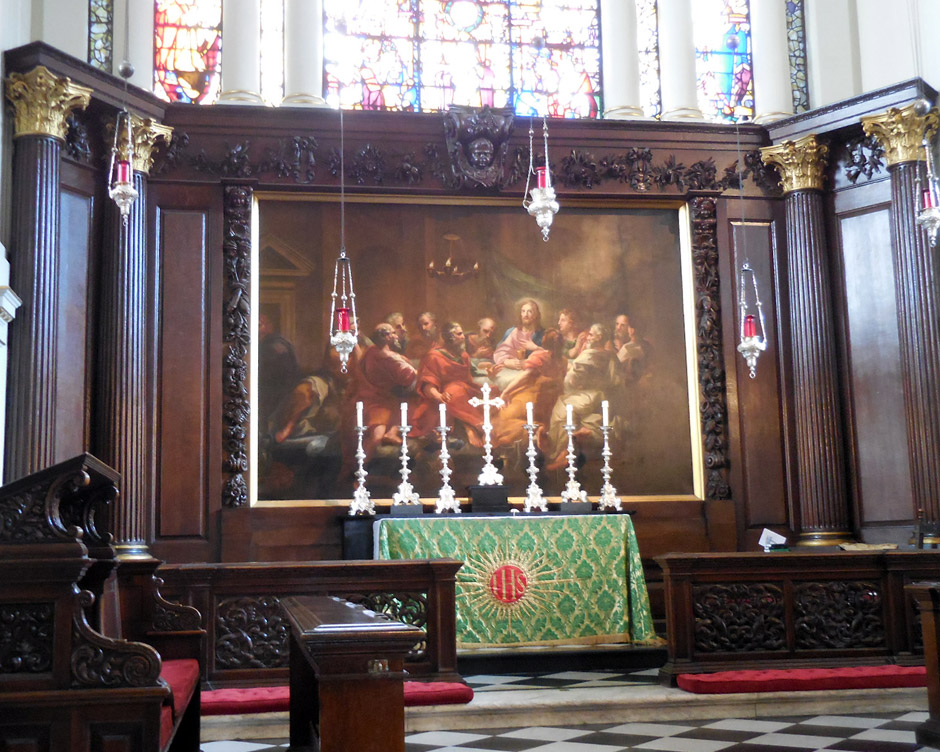
The Last Supper
Sadie Cambridge and Albert Enders
![]() Sadie and Albert Enders were born in Australia, but their love of skating brought them to South Africa and England before landing in Canada in 1940. The Enders’ were coaching pioneers in singles, ice dance, and particularly pairs, having been pair skaters themselves. The coaching duo guided Skate Canada Hall of Famers Suzanne Morrow and Wallace Diestelmeyer to Olympic and World bonze medals in 1948, among many other of their students’ successes. The Enders are being honoured posthumously.
— Skate Canada Hall of Fame, Skate Canada Announces Hall of Fame Class of 2017. [7]
Sadie and Albert Enders were born in Australia, but their love of skating brought them to South Africa and England before landing in Canada in 1940. The Enders’ were coaching pioneers in singles, ice dance, and particularly pairs, having been pair skaters themselves. The coaching duo guided Skate Canada Hall of Famers Suzanne Morrow and Wallace Diestelmeyer to Olympic and World bonze medals in 1948, among many other of their students’ successes. The Enders are being honoured posthumously.
— Skate Canada Hall of Fame, Skate Canada Announces Hall of Fame Class of 2017. [7]
![]() With ineffable grace and admirable skill a flight of golden and silver white butterflies darted and swooped, swerved and pirouetted on the ice at the Glaciarium last night, in the ballet produced by Mr A Enders and Miss Sadie Cambridge, in the course of which these two artists gave an exhibition which expressed the poetry of motion as only the expert skater can interpret it... Intricate figures and movements were accomplished with consummate ease, and the whole thing was a delight to watch. Later in the evening an exhibition of ten-stepping and waltzing was given by Miss Cambridge and Mr Enders, which further demonstrated their mastery of the art.
— The Argus, September 1924 [203]
With ineffable grace and admirable skill a flight of golden and silver white butterflies darted and swooped, swerved and pirouetted on the ice at the Glaciarium last night, in the ballet produced by Mr A Enders and Miss Sadie Cambridge, in the course of which these two artists gave an exhibition which expressed the poetry of motion as only the expert skater can interpret it... Intricate figures and movements were accomplished with consummate ease, and the whole thing was a delight to watch. Later in the evening an exhibition of ten-stepping and waltzing was given by Miss Cambridge and Mr Enders, which further demonstrated their mastery of the art.
— The Argus, September 1924 [203]
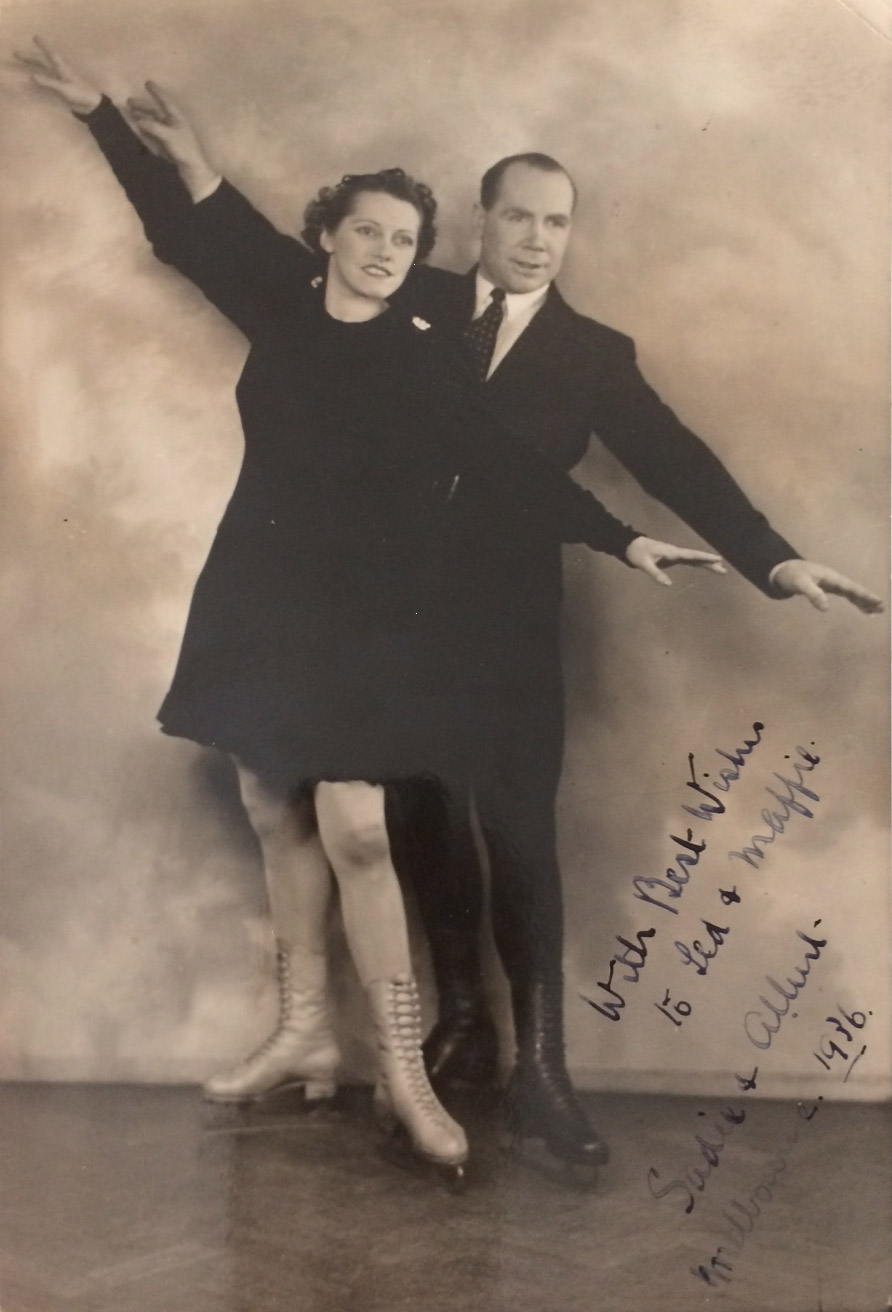 — "With Best Wishes to Ted and Maffie (Molony), Sadie and Albert, Melbourne, 1936." Courtesy Beryl Black.
— "With Best Wishes to Ted and Maffie (Molony), Sadie and Albert, Melbourne, 1936." Courtesy Beryl Black.
I STAND AT OXFORD AND REGENT, gateway to Europe's favourite shopping street, considering the geometry of my next move. In its first year, this Shibuya style crossing inspired by Tokyo’s famous district allowed more than 200 million people to cross the road diagonally in an X. The prime gateway to London’s West End, it simultaneously stops cars from all four directions to allow people to cross, like the T-intersection of Flinders and Elizabeth back home. As interesting as the new design of Oxford Circus is, I am just passing through to Hanover Square in Westminster, with the aid of a tyrant wind.
Most of the 18th-century house architecture of the Square has gone, replaced by modern offices such as Vogue House where shoots get prepped and some of fashion's most famous pages are dreamt up. I pass William Pitt the Younger and walk a short distance south to where St George meets Maddox, grumbling to my imaginary friend about the urban cancer of mock reconstruction.
According to architectural historian, Sir Howard Colvin, the church now rising before me is to the design of a competent architect lacking inventive fancy. "His buildings are for the most part plain and unadventurous in design". At least in the learned opinion of the man who talked the Oxford University building Committee out of neo-Georgian in favour of new architectural thinking. Colvin is okay in my book.
Architect John James did however work on St Paul's Cathedral with Sir Christopher Wren, and his St George's, Hanover that I have just entered is after all the most desirable place in London to tie the knot outside Westminster Abbey. Built at the start of the Georgian era, it was the most fashionable church in Regency London. The chairs used at weddings are worth £250,000 each, and its most famous worshiper was the composer Handel.
A painting on the reredos above the altar draws me down the centre aisle, leading me to wonder whether the epitome of betrayal it depicts is somehow related to the extraordinary number of weddings it has witnessed.
Nearby in the Great Depression were four very luxurious skating clubs in Grosvenor Square, Park Lane and Millbank, and some very good public rinks. And perhaps this explains why in June 1931 this "plain and unadventurous" Regency room was where a boy skater from working-class Collingwood in Melbourne married a girl skater from working-class Alexandria in Sydney. It was in this chancel before William Kent's painting Last Supper, that Albert Enders and Sadie Cambridge made their vows.
ALBERT PHILLIP ENDERS WAS BORN in 1898 to parents Bernard Enders and Maria Josine James at North Fitzroy in Melbourne's inner city. The family home was at 59 Keele St, Collingwood. [106] Sadie was born Sarah Elizabeth MacCambridge on March 25th 1899 at 60 Garden Street, Alexandria, an inner suburb of Sydney, Australia. [420, 421, 422] She was the only child of James MacCambridge, a railway labourer from Glasgow, Scotland, and Elizabeth Lyons of Sydney.
"Sadie Cambridge learnt to skate at this very rink" announced the president of the national figure skating association, Chas Maclurcan, welcoming back the Worlds Professional Champions at Sydney Glaciarium in 1934. "And doubtless fell upon her south end as much as any of us." Both were eight years-old when the first ice rinks opened in their respective cities. Even when Sadie Cambridge practised her edges as a pig-tail schoolgirl, and later on aspired to a spiral or so, people used to remark on the fearless skater that she was. [8]
"Even when I was only a beginner," she confessed in a 1933 interview, "I used to watch other people better than myself, and say, 'Never mind, Sadie, you'll be a better skater than that yourself some day.' But it takes hard, hard work to get to the gold medallist standard, and years of practice." Albert Enders was her skating instructor at Sydney Glaciarium, and by the time they were in their early-twenties they were performing skating exhibitions at both of Australia's only ice rinks in Sydney and Melbourne.
At the Melbourne Academy of Skating in 1923, they worked with John Goodall, Jack Gordon and Lena Uksila, a professional instructor from New York's Hippodrome. In September, they were among the prominent Sydney skaters who visited specially for the "Carnival of 3,000 Lights" in Melbourne, again with Uksila and her partner. [146, 147] In May 1924, billed as "Australia's Most Graceful Skaters," they performed an "entirely new exhibition" at Melbourne Glaciarium.
The next year, they demonstrated fancy and acrobatic skating, including the "Swiss Death Swing", while Cyril MacGillicuddy performed free and figure skating. The Swiss men's figure skating champion, Henry Witte, was also an instructor at the Melbourne academy that year, when more than 4,000 people attended the opening of the season in May, and about 1,000 skaters "skimmed over the ice under a brilliant canopy of amber lights." [143]
Enders recognised a potential champion in Cambridge after one season. The duo were performing quite advanced skills for the era, including adagio neck spins [3] and death spirals. They were both in their mid-twenties when he suggested she should take her talents abroad, and the pair left for England under engagement to the newly opened London Ice Club. One successful season later and they were life partners. [8]
"It was the opening of the Ice Club in 1927 which began the present boom in indoor skating," reports a 1936 Yorkshire Post. [9] Inaugurated with a special dinner on January 14th 1927, the venue was a private members club at John Islip Street, near what is now Tate Britain at Millbank in Westminster. Members paid an annual subscription on top of the entrance fees. Ten seasons later in 1936, the purpose-built premises were re-christened Westminster Ice Rink and opened to the public. [9]
The professional skating duo gave exhibition opening nights at all the important English skating clubs, including Streatham, Purley, Golders Green, Hammersmith, Oxford and Hove. They skated in exhibitions on most of the big rinks in Switzerland, which were all outdoor rinks attached to the better-known hotel resorts, such as St Moritz. Like others in the early years, they traveled to wherever they thought they could further their skating. Cambridge achieved the NSA Gold Medal standard there at the London Ice Club in 1929. She was 29. [8]
Although based in London for many years from 1927, the pair still returned home regularly to teach and perform in the European off-seasons. They popularized the side-by-side Jackson Haines spin in the Twenties, [3] and always spoke with enthusiasm of the recent development of the ice ballet and ice dancing in Europe. Both were among the mere handful of people who held the NSA of Britain's gold medal for skating.
Skating in London was very fashionable among the aristocracy, and the couple suddenly found themselves in the company of leading members of London society. The glamourous heiress Edwina Ashley who married Louis Mountbatten was their pupil and also their age, a socialite whose vast social circle included royalty, film stars, celebrities, and politicians. Lady Mountbatten supplied posh London with much of its gossip. A "man-eater", according to her daughter Lady Pamela Hicks, [10] she preferred travelling the world with her current lover to mothering her children.
Their Birkenhead pupils no doubt included Frederick Smith, a British historian who inherited his father's peerages in 1930, and later wrote a biography of Rudyard Kipling so controversial he never lived to see it in print. His sister Eleanor worked for some years as a society reporter and cinema reviewer, before travelling more widely as a publicist for circus companies. Many of her romances were adapted for the screen by Gainsborough Films.
Their father, F E Smith, patriarch of the Birkenhead earls, attained high office in the early-1900s, in particular as Lord Chancellor responsible for the efficient functioning and independence of the courts. Noted for his wit, pugnacious views, and hard living and drinking, he is perhaps best remembered today as Winston Churchill's greatest personal and political friend.
Back home the press drilled Cambridge for fashion tips, "For morning skating black velvet outfits are largely favoured and for afternoon wear bright colours, especially red, green or lemon." [381] Her skating philosophy was simple. "It takes three to four months to learn to get round," she said, "from four to five years to become a good skater, and then one has the rest of one's active life to develop the art of skating, which is as great an art as drawing or any of the allied arts." [381]
"Australia had rinks 25 years ago," she continued, "and England began to follow a few years back, but today there are seven or eight rinks in London alone, although the first English centre was Manchester where Mr Enders and I have done much display work. Among our pupils in London have been Lady Louis Mountbatten, Lord Dunmore, and the Birkenhead family, and they have set a fashion which has grown immensely owing to the really beautiful ice ballets put on in the theatres.
"Mr Enders, my partner, arranged the ice ballet for Wild Violets. The only difference between it and a dance ballet is that the ice skater holds the knee loose. The dancers all wore skates, but the composition 'ice' was the domestic soda. Our last ballet was Madame Pompadour at the Grosvenor, where the Prince of Wales, who is an enthusiastic follower of skating, was present." [381]
There was not that much overlap between dance and pair skating in the 1920s, even though both dealt with movement, balance and poise. Pair skating focused on athleticism, while dance concentrated on artistry, and for some the whiz bang death spirals, bedazzled costumes and popular music made skating seem something like ballet's embarrassing cousin.
The Enders borrowed heavily from the London stage in the belief they achieved greater beauty by combing athleticism and artistic style, and it was indeed a balance of both that eventually came to define the sport as it entered the twenty-first century. "Skating is becoming more difficult every year," observed Enders over half a century earlier in the Depression. "The recent improvement in the loops, counters and brackets which have been developed from the classic figure of eight requires a greater degree of accuracy. " [382]
Cecilia Colledge is credited with inventing both the camel and the layback because she performed them in the early-1930s. But Ray Stevens [3] has pointed out, legendary figure skating coach Gustav Lussi frequently told his students the spin was called the Campbell spin after an Australian who created it at the Toronto Skating Club in the Twenties. "Camel" was a corruption of "Campbell" according to Lussi, but no-one knows who Campbell was, and it seems more likely it was Cambridge, as Stevens suggests. [3, 11]
In May 1930, the year before Enders and Cambridge married, they visited New York City aboard the RMS Mauretania and performed at the St Regis Hotel where Lussi directed and choreographed shows. [3] After they married, the duo became husband-and-wife World Professional British Pair Skating Champions no less than seven times in succession between 1932 and '38.
In 1933, they moved their base to the Queens Ice Skating Club in Bayswater, which had opened in 1930 on the site of today's Queens Ice Dance Club. It had a six months' winter season, but it still allowed them to teach at Sydney Glaciarium for its shorter season of three months. [8]
On May 25th 1935, the pair gave a gala performance at Sydney Glaciarium filmed by Fox Movietone News for a 16mm newsreel released in August that year. At the time, Enders still taught and produced ice ballets at Queens. They returned from London for five weeks due to the illness of Sadie's mother, with their young pupil, Daphne Walker. Enders had coached Walker since she started skating at seven, and was now training her at eleven for her first European and world championships. She would be eligible after she turned twelve. [404]
In January 1936, they again performed at the famed Palais Des Sport in Paris and played ice hockey before 15,000 people. Later, they invited ice hockey player and speed skater Ken Kennedy to join their traveling troupe, where he learnt some of the finer points of ice sports from Enders, including barrel jumping. [430] Australia's first winter Olympian, Kennedy played ice hockey and ice raced in England. Sadie long held an interest in ice hockey and encouraged Australians to play it more. "Australian ice hockey teams, the members of which had learnt to play together, could beat any English team and attend the Canadians." [381]
In June 1936, they returned to Sydney Glaciarium, now traveling regularly with their young pupil. Then in 1936–7, working daily from early morning until after midnight, they managed, taught, performed and eventually turned South Africa's Empire Exhibition ice rink in Johannesburg from "a hopeless proposition ... into an unqualified success both financially and socially." All three performed there with the Exhibition in September 1936. [404]
When the couple returned to England, their students at the Queens Arena, London included Pamela Davis MBE and Mollie Phillips, both of whom later became International Skating Union Judges. In 1938, the couple performed in Tom Arnold's Switzerland Musical Extravaganza on Ice at the Liverpool Empire. [5] British champions Phil Taylor and his daughter, Megan Taylor, starred in the show in Australia the next year.
In July 1939, they were back at Melbourne Glaciarium before 3,000 people with Joyce Macbeth, three-time women's professional champion of Great Britain; Nate Walley, professional champion of the world in 1934 and 1935; and Walker who was by then a gold medallist of Great Britain, and fourth-placed in the British open championship.
Daphne Walker skated the eleven-mlnute programme she performed for the British championship, [383] and went on to become the 1939 World women's figure skating bronze medalist, the 1947 silver medalist, and the 1939 and 1947 European bronze medalist. Joyce Macbeth first toured Australia in 1934. She remained and married Australian figure skating champion, Frank Mercovich, a board member of the inaugural Australian ice skating association in 1931.
The Pictorial and Descriptive Guide to London published in 1935 lists "real ice" rinks at Golders Green, Hammersmith, Streatham, Bayswater and Richmond. The London skating craze was curtailed by the outbreak of the Second World War. The capital's ice rinks were closed and given over to other purposes. [9]
THE VICTORIA SKATING RINK at 1475 Drummond St in Montréal hosted the first-ever recorded organized indoor ice hockey match on March 3rd 1875. A two-storey, block-long building replaced it in 1913 when the city was a mecca for elite figure skating. Built in 1912 by celebrated architects Edward and William Maxwell, the Montréal Winter Club was the most prestigious private sports club in the city, and it played a founding role in the history of organised figure skating in Canada.
It was the headquarters of the forerunner of Skate Canada, known then as the Canadian Figure Skating Association, and it hosted the 1932 World Figure Skating Championships, the 1935 North American Figure Skating Championships, and the 1941 Canadian Figure Skating Championships.
Melbourne professional skater Gwen Chambers worked at the Winter Club for two seasons from October in 1937 and 1938, while her brother Ron worked at the Granite Club, Toronto. It was the Winter Club that Enders and Cambridge chose when they finally moved to North America, still returning to teach in the North American off-seasons. [6]
Departing Sydney early in June 1939 on the Queen Mary, they went to Hollywood that year and took Walter Ridge to Scotland in late-1939 to perform with them in Tom Arnold's new summer ice show venture, Ice Follies. Ridge balanced the gold fish bowl in the skating scene of the film There Goes My Heart (1938), with Frederic March and Virginia Bruce. [11]
Now in their forties, their Montréal students included Dwight and Libby Parkenson and Norman Gregory. Commandeered by the Royal Navy with World War II looming, the Winter Club did not reopen after the war. Its famous 1870 painting Carnival by William Notman now hangs on the main stairway leading up to the second floor of the Montréal Badminton and Squash Club. It depicts a festive skating scene from the Winter Carnival held each year at the Winter Club.
Over the years that followed, students of the Enders won most of the Pairs and Fours in Western Canadian Championships, as well as many Dance Championships. At the Garden City Arena and the Toronto Skating Club, the couple coached Suzanne Morrow, Wallace Diestelmeyer, Frances Dafoe CM O.Ont, Norris Bowden, Ann Aubin, Elizabeth and Barbara Gratton. Their pupils at Icelandia, a privately-owned rink at 1914 Yonge Street in Toronto, thought of them as "the world's most famous skaters and teachers."
At the Connaught Skating Club, founded in Vancouver in 1911, they coached Suzanne Morrow and Wallace Diestelmeyer between 1946 and '48; Junior Ladies and Junior Men's Champions (1946); Senior Pair Champions (1947–8); and Senior Dance Champions (1948). They coached the 1st Junior Pairs, Pearl Simmers and David Spalding (1948), Audrey (Downie) Williams and Brian Power (1951), and Pat Spray and Norman Walker (1952). Williams and Power finished second in pairs in Canada in 1952 and 1954. Williams gave over five decades to the sport, a long-time Olympic and international judge inducted into the BC Sports Hall of Fame in 2011.
Early in 1947, the Enders arranged an engagement at London's Wembley Stadium for their Toronto Pairs students, Suzanne Morrow and Wallace Diestelmeyer. The Australian couple performed at its opening and knew the managing director, Sir Arthur Elvin. Morrow and Diestelmeyer developed the current one-handed version of the death spiral in the 1940s, first invented by Charlotte Oelschlagel in the early-1900s. They went on to win Canada's first ever Winter Olympic medal in the Pairs event — bronze in 1948 at St Moritz, Switzerland.
The international coaching success of the Australians continued eight years later in Cortina d'Ampezzo in Italy where two more of their Toronto Pairs, Frances Dafoe and Norris Bowden, won the silver medal. Both couples also produced World Championship titles in pairs skating: Morrow-Diestelmeyer won Silver (1948, Davos) and Dafoe-Bowden won Silver (1953 Davos); Gold (1954, Oslo and 1955, Vienna); and Silver (1956, Garmisch). Both these skating pairs were inducted to the Skate Canada Hall of Fame.
Morrow and Diestelmeyer are credited as the first pair to do the death spiral. Morrow also competed as a singles skater in the 1948 and 1952 Winter Olympics and served as a figure skating judge for over fifty years. At the 1988 Winter Olympics in Calgary, she took the Judge's Oath, the first woman to do so at the Winter Olympics.
Dafoe and Bowden were the first pair skaters to do the twist lift, throw jump, leap of faith and overhead lasso. It was because of these two that some of the rules in pairs skating changed. Bowden has since been inducted into Canada's Sports Hall of Fame (1955), the Canadian Olympic Hall of Fame (1958), and the Skate Canada Hall of Fame (1993).
Between 1947 and 1960, the Enders presented ice shows all over British Columbia with skaters such as Linda Brauckmann, Brian Power, Pamela Wellman, Canadian pairs medalists Pearle Simmers and David Spalding, Joan (Penfold) Glynn, Margie (Penfold) Sandirson, Ann Doherty, Canadian dance champion Fran Gunn, and Dorothy McLeod. Sadie died at 69 on September 1st 1968 at Vancouver in Canada. [420, 423] Albert died a short distance south in Seattle in 1976. The couple have an entry in The Historical Dictionary of Figure Skating by James R Hines.
Enders and Cambridge developed their skating in the earliest years of Australia's first ice rinks, and went on to win the Open Professional Championship of Great Britain seven times. They were coaching pioneers in singles, ice dance, and particularly pairs, and trained some of the top young skaters of their time in Australia, England and Canada. This Australian coaching duo guided Skate Canada Hall of Famers Suzanne Morrow and Wallace Diestelmeyer to Olympic and World bonze medals in 1948, among many other of their students’ successes.
In 2017, Sadie and Albert Enders were the first Australians inducted to the Skate Canada Hall of Fame.
We are indebted to the Australian Professional Skaters Association who first drew our attention to the work of Sadie and Albert. Some of the biographical information and imagery we have used is from their original website which has since been replaced.
[1] Enders two sisters who survived infancy were Irene May, born in 1894 at North Fitzroy, and Ruby Kathleen born in 1896 at Collingwood. Enders' father died in Melbourne in 1920.
[2] Sadie was a swimmer at the Metropolitan Ladies Club in Sydney in 1911 when she was 12.
[3] "The history and evolution of spinning," Ryan Stevens, May 4 2017, Skateguard website. Last access Nov 2017. Online The origin of the Camel Spin is also mentioned in a Wikepdia article
[4] British Pathé hold film footage of Daphne Walker at Wembley and Davos.
[5] The cast of "Switzerland" included Eddie Marcel, Betty Somerville, Elsie Derksen, Rudie Angola, Iris Goater, Maurice Barlow, Hope Braine, Melitta Brunner, Barbara Matthews, Harry Torrani, Barr and Estes, Kendall Capps, Arren and Broderick, Bruce Mapes and Hazel Dawn, Diana Grafton, and the Lindstrom Brothers.
[6] The Argus, Melbourne, 1 Mar 1938 p 18; May 6 1939 p 41.
[7] Skate Canada Hall of Fame, "Skate Canada Announces Hall of Fame Class of 2017", Aug 14 2017.
[8] The Sun, Sydney, June 4 1933, p 24.
[9] The Yorkshire Post, England, 2 May 1936. "The craze for ice skating in London", Beatrice Behlen, Museum of London, 2017.
[10] "Daughter of Empire: My Life as a Mountbatten", Pamela Hicks
[11] The Age, Melbourne, 7 Oct 1939, p 12.
[106] "Historical Index", Registry of Births, Deaths and Marriages, Department of Justice, Melbourne, Victoria.
[143] The Argus, Melbourne, 8 May 1925.
[146] The Argus, Melbourne, 19 Sep 1923, p. 20.
[147] The New York Times, Nov 3rd 1918.
[203] The Argus, Melbourne, 26 Sep 1924, p 12. Skating Carnival.
[404] The Advertiser, Adelaide, 3 June 1936, p 9.
[420] Email from Sharron Ibbotson and Dennis Lyons. Special thanks.
[421] New South Wales Births Deaths and Marriages. Last access: 30 Jul 2013.
[422] Steve Lyons Ancestry.com post: looking for relatives of Edmond John Lyons, b. 6/7/1850 d. 5/9/1937 in Annandale NSW.
[423] British Columbia Canada Death Index, 1872-1990. Sadie Elizabeth Enders died 1968.
[430] Referee, Sydney, Thu 17 Mar 1938 p 3. Article "Skater Ken Kennedy Turns Pro."


